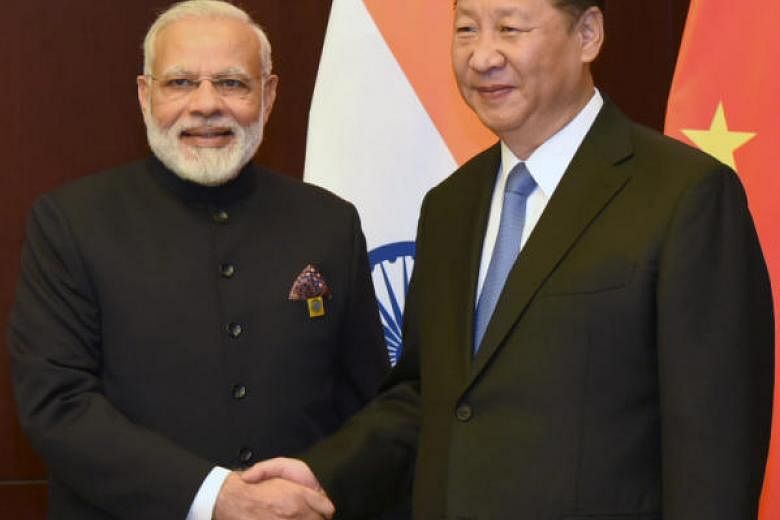Leaving Dalian on an Air China flight operated by Dalian Airlines earlier this month, I was surprised to hear what appeared to be chanting of Sanskrit hymns as I settled into my seat.
The Hindi movie, Dangal (Wrestling Bout) had been popular in China and I assumed that the Chinese man in the seat next to me had seen it, and was trying out other aspects of Indian culture on his mobile phone. Hence, the music.
Turned out I was wrong.
The Sanskrit shlokas I could hear were actually soothing, pre-takeoff music playing on the jet's public address system. Maybe they just added it to the music list because the songs sounded mellifluent and calming.
Looking down at a copy of the Global Times I had picked up from the airport's lounge I got another surprise.
There was a single column news on the ongoing border tension between China and India in the World section, but across the top of a page was a big picture of a lamp-lighting ceremony in a Hindu temple of northern India, complete with explanations of which Gods were being propitiated.
Indians have been raised to think suspiciously of Chinese ever since 1962, when the two fought a border war that went badly for them.
The full story of that war has never been told to them, so the widespread perception is that of a Chinese 'betrayal' despite founding Prime Minister Jawaharlal Nehru's slogan of 'Hindi-Chini bhai bhai' - Indians and Chinese are brothers.
This week, as they read about their National Security Advisor Ajit Doval travelling to Beijing and meeting President Xi Jinping and State Councillor Yang Jiechi amid one of the worst crises in bilateral ties brought on by a standoff on their Himalayan frontier, the view of China as an enemy state would have been further cemented in Indians minds.
They would be surprised to hear the view from the other side is far more nuanced, and significantly less hostile.
How so?
Years ago, I travelled to the Orind Special Refractories in Bayuquan, a rust-belt town in Liaoning province. Orind was among the first Indian companies to invest in the mainland.
There, Chinese workers happily worked under the supervision of Indian managers. More than one worker I met spoke of the harmonious relationship.
One of them - Cheng Wei, 32, who had earlier worked for a Japanese employer - said the Indians were far more considerate bosses.
"Many Chinese are in important jobs here and the management invites us along for important meetings," Ms Cheng told me, explaining why she had stayed eight years with Orind. "On the other hand, Japanese and Korean bosses tend to not mix too much."
A similar comfort level also prevailed in white collar jobs when I visited an outsourcing campus in Hangzhou, run by India's top IT services company, Tata Consultancy Services.
Chinese and Indians worked side by side, with mutual respect for the skills each brought to the job.
Two years ago, I spent a morning at a PLA think-tank in Beijing along with a bunch of other journalists gathered under the Jefferson Fellows programme organised by the East West Center in Hawaii.
The PLA brass there, I noticed, treated an Indian journalist in our bunch of multinational Fellows with considerable respect. A Japanese colleague though was given a rough time, with plenty of finger-wagging.
Perhaps all this is because the cultural contact between China and India go back centuries. Millions of Chinese have since childhood been familiar with Journey to the West, the story of a Tang dynasty monk who travelled to India to get the authentic Buddhist sutra.
In the southern Indian state of Kerala, the woks used in kitchens are called 'cheena chatti' - Chinese woks.
Kerala was the first in India to receive Islam, brought peacefully by Arab traders when Islam became the religion of the Middle East. But a second peaceful thread of the faith came from South-east Asia and the voyages of the Chinese seafarer Admiral Zheng He, who made several visits to Kerala and was Muslim. To this day, Chinese fishing nets add beauty to the lagoons that dot the state.
According to some accounts, Buddhist monks travelling from Kerala to China in the 6th century carried with them the skills that evolved into the Shaolin Chuan. Needless to say, Shaolin monks deny the connection is that strong.
This is not to suggest that strategic rivalries do not exist between Asia's twin tectonic plates, or that mutual suspicions are not without foundation.
A resurgent India confronting a China that's rapidly grown to middle income status and eyeing parity with the US, will have its issues.
The wise thing, though, is to acknowledge that there is no way out but to find balance in the relationship through mutual accommodation of core interests.
The peaceful civilizational exchanges of centuries are too valuable to be lost in the heat of contemporary animosities.


